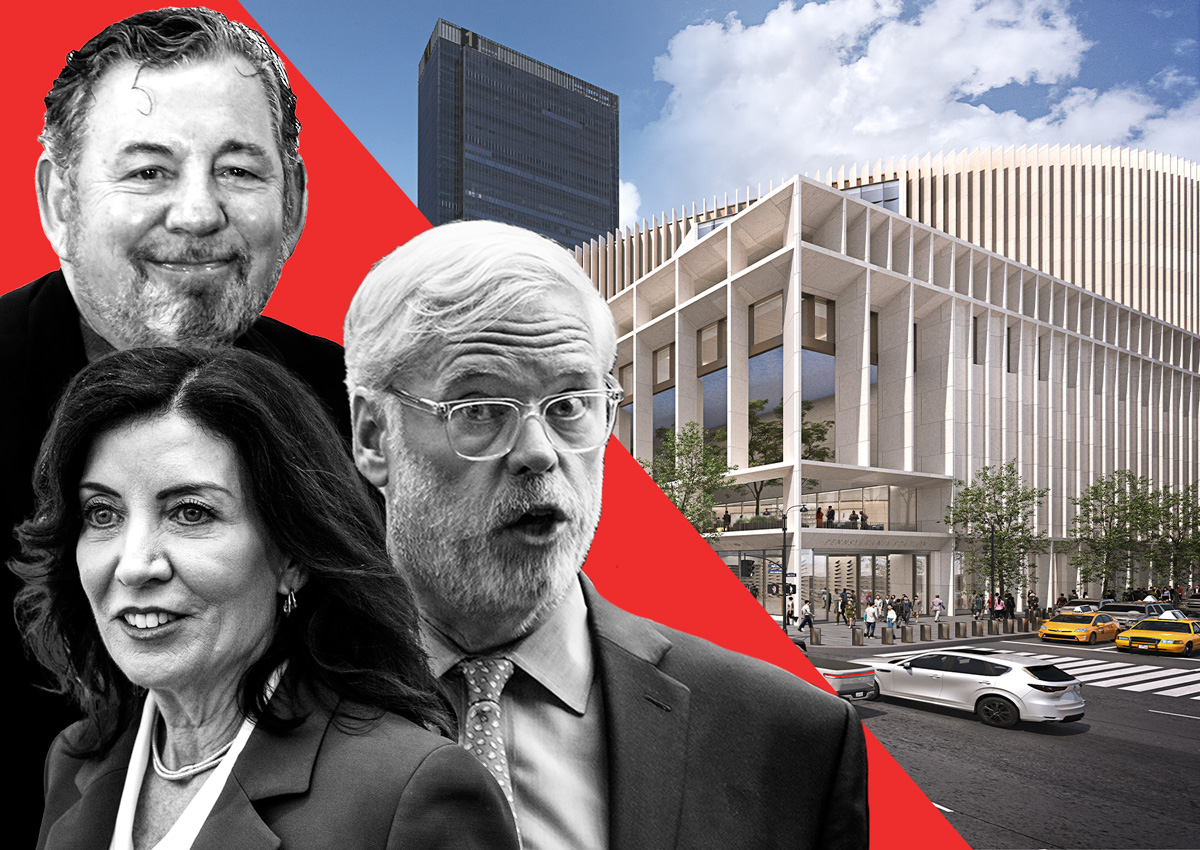
For an incredibly complex project, the pitch for Penn Station was simple: Our idea is better, cheaper, and probably won’t get you sued.
That’s the message of a campaign by ASTM North America, Inc., which is leading a team aiming to win the long-sought award for a transportation hub overhaul project. The group estimated its plan would cost $6 billion, $1 billion less than the state’s forecast for its plan.
ASTM’s alternative is for the company to buy the Hulu theater from Madison Square Garden for less than $500 million and tear it down. According to the team, this is the price MSG is proposing (previous reports pegged the acquisition cost at $1 billion).
Demolition of the venue would eliminate the problem of trucks entering and leaving the venue – an issue at the heart of the debate over the renewal of MSG’s special permit.
ASTM North America, a subsidiary of an Italian company, is part of the MTA’s first public-private partnership to upgrade more than a dozen stations. Its Penn team includes some heavyweights, including CEO Patrick Foye, who served as MTA chairman and ran the Port Authority, and Vishaan Chakrabarti’s PAU and HOK, who are helping to redesign LaGuardia Airport Terminal B. Lendlease also participates in ASTM’s Pennsylvania program.
But — and this is a big but — the state has been on a separate track. On Monday, Gov. Kathy Hochul announced the “beginning of the design process” for an overhaul of Penn. Hochul said she is open to all ideas for the space station, but will continue to implement a $58 million contract awarded last year for initial construction and engineering work.
The agreement doesn’t prevent other companies from tackling the project — a request for proposal will be issued following an environmental review — but it could limit what kind of retrofits Penn can make.
Hochul also said the redesign will be based on the MTA’s station master plan, which includes creating a station concourse in the middle of the block and excluding the grand Eighth Avenue entrance. An MTA representative said the agency is skeptical about the entrance there because it has less traffic than on the Pennsylvania Seventh Avenue side, but will study it during the initial design phase.
“Governor Hochul is moving full speed ahead with the Penn Station improvement plan and putting commuters first,” a spokesman for the governor said in a statement. “Once the initial design phase of the project is complete, the RFP process for the construction phase will will begin and we will review all submissions.”
ASTM wants the governor to issue a request for proposals for Penn’s master planners, enabling it to move forward with an incremental public-private partnership model that calls for early involvement in all aspects of the project.
“I’m an optimist. I believe policymakers want to do the right thing for commuters,” Foye said in a speech at the PAU’s offices in Union Square.
The team was heartened by the Premier’s acknowledgment that the state’s proposed design was “conceptual”. It also highlights the amount of engineering work that has been done in its program.
“Anyone can render,” Chakrabarty said. “With something this complex, you can’t just render and imagine you have a process.”
ASTM will create a 55-foot entrance on Eighth Avenue, which will become a light-filled lobby by removing the Hulu Theater. Removing the theater’s mechanicals will provide a new interior loading area for trucks, which will enter at West 33rd Street and exit at West 31st Street.
The head of the MTA, Janno Lieber, has been skeptical about the idea of demolishing the theater.He puts the cost of replacing the new entrance at $2 billion.
Like the state’s plan, ASTM is calling for a new train station hall in the middle of the block. But there are also significant differences. The railroad agency has proposed lowering a portion of a disused taxiway owned by MSG to accommodate truck traffic. Additionally, plans for the state’s new train station call for the removal of a pedestrian bridge that included HVAC equipment “vital” to the Rangers’ games, according to MSG.
ASTM’s plan does not call for the bridge to be demolished, a move the team believes could lead to litigation.
The Farley Building across Eighth Avenue echoes the McKim, Mead & White-designed Penn Station, which was demolished more than half a century ago. ASTM’s Penn renovation will similarly complement Farley, with limestone or granite facades and a modern colonnade.
MSG at odds with railways
Whether ASTM’s plan moves forward or is added to the graveyard of grand but abandoned visions for the station, a battle is brewing between the railroad agency and MSG.
While seeking a new special permit to continue operating the facility, its owners clashed with the MTA, Amtrak and NJ Transit over its loading operations on West 33rd Street. In a report to city planning, the rail agency said the loading operations were “incompatible” with plans to revamp Penn Station. To be compatible, the stadium “must agree to cooperate in a property exchange,” including an interest in an abandoned taxiway on Eighth Avenue.
MSG balked at that characterization, writing to the city planning agency last week that “conceptual plans for the redevelopment of Penn Station do not work” and that a willingness to work with the agencies does not imply consent “in any way.” Transferring ownership of our private property at less than fair market value.”
Under ASTM’s plan, the company will operate and manage the station for 50 years, paying the railroad an estimated $250 million a year and expecting returns of 8% to 11%.
The group will provide $1 billion in equity upfront for the redesign, and then rely on about $2 billion in public subsidies (mainly grants from the U.S. Department of Transportation) and $3 billion in federal loans. This approach requires the sign-off of elected officials as well as numerous railroads and federal agencies.
The governor said this week that the master plan would tap into the initial $1.3 billion the state had set aside for the project, some of which was included in ASTM’s estimate, and hoped the state would receive federal funding.
Members of the ASTM team have repeatedly referred to their relationship with MSG as a “collaboration.” But they hesitated when asked what Vornado Real Estate Trust thought of its plans. Foye said they had a productive conversation with Steven Ross’ REIT. Chakrabarty said the redesign would boost the value of Vornado’s surrounding Pennsylvania properties. ASTM’s Peter Cipriano chimed in, thinking Vornado “thought it looked great.”
Vornado did not immediately respond to a request for comment. While the governor has shelved larger development projects in the wider state around Pennsylvania, much of it involving the Vornado station, any redesign of the station would require the company’s cooperation.
Chakrabarty said the proposed station expansion and other projects envisioned by Penn are “critical,” but revamping the existing station is at the heart of it.
“Really, we think of ourselves as the jelly in a donut,” he said. “In order for all of this to be one coherent place, you have to fix the station, because that’s where the vast majority of people are.”







